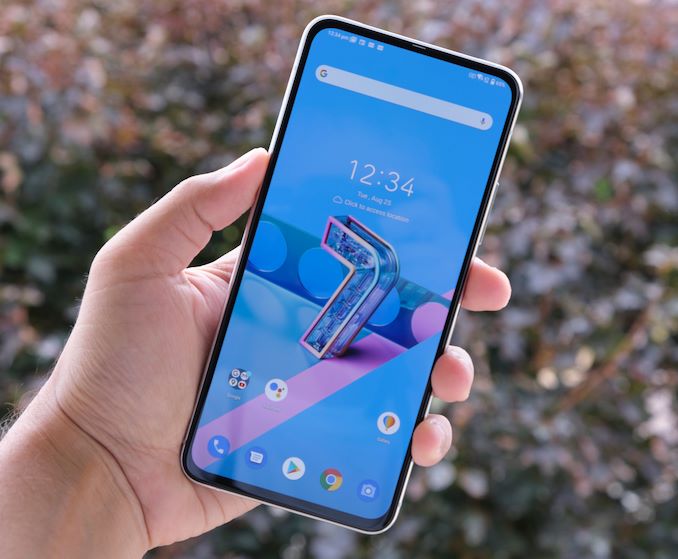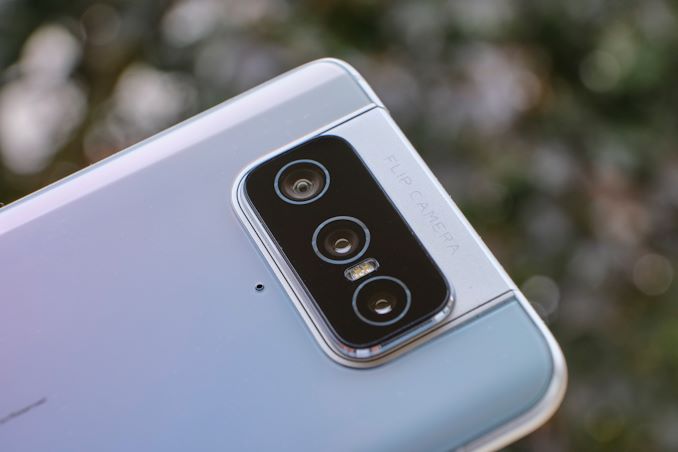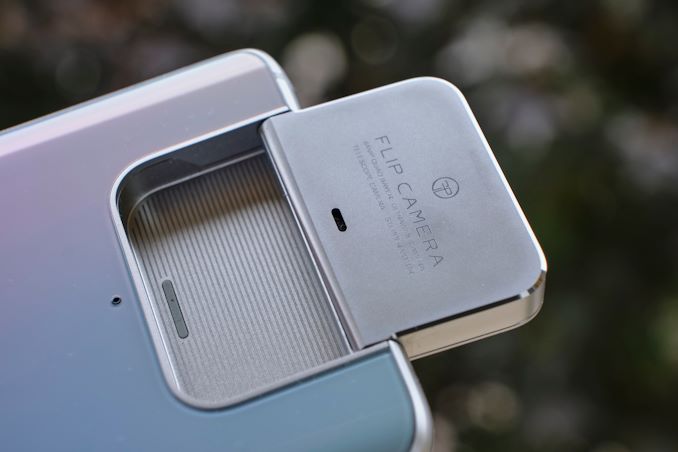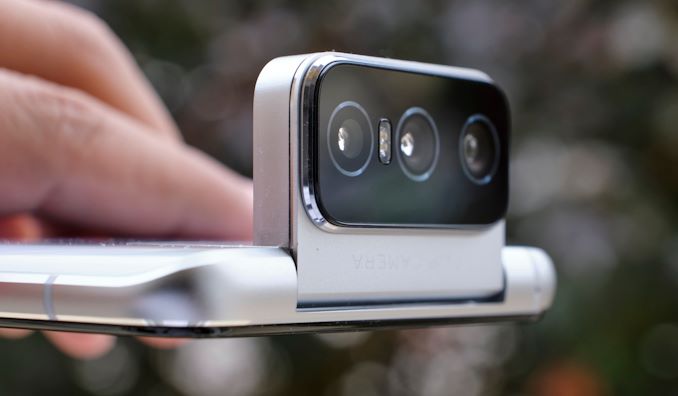The ASUS ZenFone 7 Pro Review: The Triple Flip-Camera
by Andrei Frumusanu on September 1, 2020 3:00 AM EST- Posted in
- Mobile
- Asus
- Smartphones
- ZenFone 7
- ZenFone 7 Pro

ASUS last week released the brand new ZenFone 7 and ZenFone 7 Pro series, and today’s we’re ready to publish our testing of the company’s newest “mainsteam” flagship device.
This year’s ZenFone 7 series, consisting of the regular ZenFone 7 and the ZenFone 7 Pro are sticking to the quite well received and innovative flip-camera design, improving upon its specification by adding in an extra camera module. We’ve also seen key specification improvements on the part of the phone itself, with an important shift from an LCD screen to a new 90Hz AMOLED display, as well as adoption of Qualcomm’s newest Snapdragon 865 and 865+ chipsets.
This year, the company is also releasing two variants of the phone – beyond higher DRAM and storage configurations, the higher-end model features a higher-binned SoC as well as differentiates the camera systems by exclusively employing OIS – which is an interesting way to segment things.
| ASUS ZenFone 7 Series | |||||
| ZenFone 7 | ZenFone 7 Pro | ||||
| SoC | Qualcomm Snapdragon 865 1x Cortex A77 @ 2.84GHz 3x Cortex A77 @ 2.42GHz 4x Cortex A55 @ 1.80GHz Adreno 650 @ 587MHz |
Qualcomm Snapdragon 865+ 1x Cortex A77 @ 3.1GHz 3x Cortex A77 @ 2.42GHz 4x Cortex A55 @ 1.80GHz Adreno 650 @ 670MHz |
|||
| DRAM | 6 GB LPDDR5 | 8 GB LPDDR5 | |||
| Storage | 128GB UFS 3.1 + microSD |
256GB UFS 3.1 + microSD |
|||
| Display | 6.67" AMOLED 2400 x 1080 (20:9) 90Hz 200Hz Touch |
||||
| Size | Height | 165.08 mm | |||
| Width | 77.28 mm | ||||
| Depth | 9.6 mm | ||||
| Weight | 230 grams | ||||
| Battery Capacity | 5000mAh 30W charging (PD3.0) |
||||
| Wireless Charging | - | ||||
| Rear Cameras | |||||
| Main | 64MP IMX686 0.8µm pixels (1.6µm 4:1 16MP) f/1.7 |
64MP IMX686 0.8µm pixels (1.6µm 4:1 16MP) f/1.7 w/OIS |
|||
| Telephoto | 8MP 3x optical zoom f/2.4 |
8MP 3x optical zoom f/2.4 w/OIS |
|||
| Wide | 12MP IMX363 1.4µm pixels Dual PDAF 113° FoV ultra-wide f/2.2 |
||||
| Extra | - | ||||
| Front Camera | Flip-camera Design Front cameras = Rear cameras |
||||
| I/O | USB-C | ||||
| Wireless (local) | 802.11ax WiFi-6 Bluetooth 5.1 LE + NFC |
||||
| Other Features | Triple-function Power Button w/ Capacitive Fingerprint Sensor | ||||
| Dual-SIM | Dual nanoSIM | ||||
| Launch Price | 21,999 TWD (USD~748, EUR~626) |
27990 TWD (USD~952, EUR~797) |
|||
Starting off with the hear of the phone, the ZenFone 7 and 7 Pro employ Qualcomm’s latest Snapdragon 865 SoCs and are thus 5G-capable devices thanks to the X55 modem. ASUS here employs the newer higher-performance Snapdragon 865+ on the 7 Pro model which brings with it 10% higher CPU and GPU performance thanks to the increased frequencies of these IP blocks.
Further variations between the regular ZenFone 7 and the 7 Pro is in the DRAM and NAND storage department. The regular variant comes with 6GB of LPPDR5 and 128GB of UFS 3.1 storage, whilst the Pro gets respectively 8 and 256GB.
The key selling point and differentiating factor of the ZenFone 7 as opposed to other phones in the market right now is the fact that it employs a full-screen display without any notch or camera cut-out, enabling a seamless screen experience without distractions.
A big upgrade this year compared to last year’s model is the shift from an LCD to an OLED screen, which makes this year’s model significantly more attractive to users. The 6.67” screen features a 2400 x 1080 resolution in a 20:9 aspect ratio, and features a 90Hz refresh rate capability.
Although 90Hz isn’t the very top of the line for 2020, it’s still a huge improvement over other 60Hz phones and ASUS did manage to employ a 200Hz sampling touch controller which has a large impact on fluidity and responsiveness when you interact with your phone.
The back of the phone sees a glass back-panel which comes either in a “Pastel White” (pictured) or an “Aurora Black” colour variant. The phone lacks wireless charging.
It’s to be noted that this is a very large phone that is in line with the iPhone 11 Pro Max and the Galaxy S20 Ultra in terms of footprint, quite a bit larger and chunkier than the ZenFone 6. This is something that ASUS actively acknowledges as being a deliberate design choice so that that they could fit in more components and a larger battery, as well as enable the various antennas requires by 5G connectivity.
The camera setup now features triple modules. As the primary main camera, we’re seeing a 64MP IMX686 sensor with 0.8µm pixels that by default bins down to 16MP thanks to its quad-Bayer colour filter layout. The optics feature a large f/1.7 aperture.
The ultra-wide-angle also adopts the same setup as on the ROG Phone III with a 12MP IMX363 with 1.4µm pixels and dual-pixel phase detect focus ability. The optics have an f/2.2 aperture with a 113° wide viewing angle. Unusual is that it features auto-focus ability which means that this module can do dual-duty as a macro module since it enables super close focusing abilities.
New to the setup is an 8MP telephoto module which offers 3x optical magnification which thanks to multi-frame interpolation can be digitally cropped and magnified to up to a useable 12x zoom in the camera app. The optics here feature an f/2.4 aperture.
On the ZenFone 7 Pro the main camera as well as the telephoto module feature OIS in their modules, whilst the regular ZenFone 7 doesn’t feature this. We haven’t seen such segmentation in some time by a vendor, but it’s one of the cost-cutting measures that ASUS has decided to make for the cheaper model.
The flip-camera externally looks familiar with what we’ve seen on the ZenFone 6, however ASUS has greatly improved the internal mechanism of the newer generation module. The new module employs a new motor that is capable of 2.2x the torque of its predecessor even though it’s 40% smaller.
ASUS has also replaced the complex 49 signal and power cables that connect the various camera modules to the mainboard of the phone with a new 18-layer flexible printed circuit cable that promises to be twice as durable even though the total signal traces has increased to 110 outputs. ASUS claims it’s good enough for up to 200000 flips, which is 100 flips a day for over 5 years.
I’ve never had the pleasure to get a hands-on with the ZenFone 6, but the camera mechanism on the 7 series feels very solid and robust.
A new feature to the flip-screen is its ability to position itself at intermediary angles from within the camera app, giving you different capturing angles, which are essentially impossible for any other phone on the market.
Beyond your typical fully-flipped 180° setup in which the cameras can serve as high-quality frontal selfie cams, the module also can sit at a 90° or 135° angle. The phone’s panorama capture feature takes advantage of the flipping module to sweep the landscape whilst you hold the phone steady.
The phone is quite thick at 9.6mm, but that’s mostly due to the 5000mAh battery that’s included, which also bloats up the device to a 230g weight.
ASUS has dropped the 3.5mm headphone jack this generation. Their rationale about the change was that due to the increased internal footprint required by the 5G antennas they had decided to do away with the jack to be able to save on space.
One thing that’s unique on the bottom of the phone is that it features an LED notification light on the left of the USB-C port. ASUS here said that they had to remove it from the front top of the screen due to the reduced bezel size, but didn’t want to abandon the light completely, so they just repositioned it to the bottom of the phone. This is actually quite useful and a more power-efficient way to handle things than an always-on-display so I do appreciate this detail.
The left side of the phone features a long SIM tray that is able to house two nano-SIMs as well as a micro-SD card simultaneously.
The right side sees a traditional volume rocker, as well as a triple-function power button. ASUS opted for a capacitive fingerprint scanner from Goodix integrated into the power button – it’s one of the cost-cutting measures allowing the ZenFone to hit a lower price-point. Beyond the traditional single-press power button function, dual-pressing the button calls up the Google assistant, and you can customise or disable this functionality.


















31 Comments
View All Comments
GC2:CS - Tuesday, September 1, 2020 - link
I find the battery lifespan saving max charge limit comparison somewhat dishonest.For the same usage you need 500 cycles at 80 and just 400 if you charge to 100. So it is more like 7 and 12% degradation.
I think limiting charge might be usefull for things like headphones. They just sit for days in their case charged to 100%.
Also I am quite woried where we are going with battery capacities. Looks like even 4000+ mAh is not a guarantee of great battery life these days.
CampGareth - Tuesday, September 1, 2020 - link
That's assuming you drop to 0% charge every single time, under that usage you're going to burn through batteries regardless. The state of charge limit is intended more for folks that stay at a high charge percentage. I can't remember the last time my phone dropped below 60%, it's on charge at home and at work so spends a lot of time sitting at 100% charge which degrades the battery faster even when it's idle.imoc - Tuesday, September 1, 2020 - link
Not true. Their graph states SoC(State of charge) and charge cycle doesn't mean Any%-80%, a full 100% battery top up counts as one(such as 30-80 two times).close - Tuesday, September 1, 2020 - link
There are a few trends to dislike, small batteries for the consumers attached to the phone (mega SoCs, gazillion Hz screens, all of the Gs, all the time), glass backs especially when not actually needing it, removing the headphone jack even on phones that are clearly big enough to fit one, etc. This phone ticks most of them.SirDragonClaw - Tuesday, September 1, 2020 - link
You need to learn how modern batteries work...huyhung411991 - Tuesday, September 1, 2020 - link
First paragraph in Battery Life section is repeated.Ryan Smith - Tuesday, September 1, 2020 - link
Thanks!linuxgeex - Tuesday, September 1, 2020 - link
Before I even look at image quality with video recording, I pay attention to the background noise. You should be able to tap the screen, adjust volume up and down, power the screen on and off, and walk in light wind without hearing distracting sounds. This camera failed this basic requirement with flying colours lol.Kangal - Tuesday, September 1, 2020 - link
Dunno, it's hard to judge the quality without a reference.The photo, video, microphone comparisons should have something like a Sony A7 + Lav, as that's basically professional quality, and it would be much easier to spot where phone's deficiencies lay.
Bonus points should be made to compare all devices on a quick Auto Mode, but Manual-Professional Adjustment on the Mirrorless. That's the most important comparison. And do it in Good Lighting, Overcast, and Low-light conditions. And do it in Macro, Regular, and Zoom modes.
Manual Modes are interesting on the new Sony Xperia 1 ii Pro, and LG V60... but are somewhat gimmicky. Phones are meant for quick "point and shoot", for professional quality you can't subsidise a phone with manual mode for a proper DSLR or Mirrorless. It would be like trying to use a hot-hatch to move heavy loads, then complaining, instead of using a pickup truck.
linuxgeex - Tuesday, September 1, 2020 - link
@Andrei - several of the camera comparison photos are missing and some are backwards.